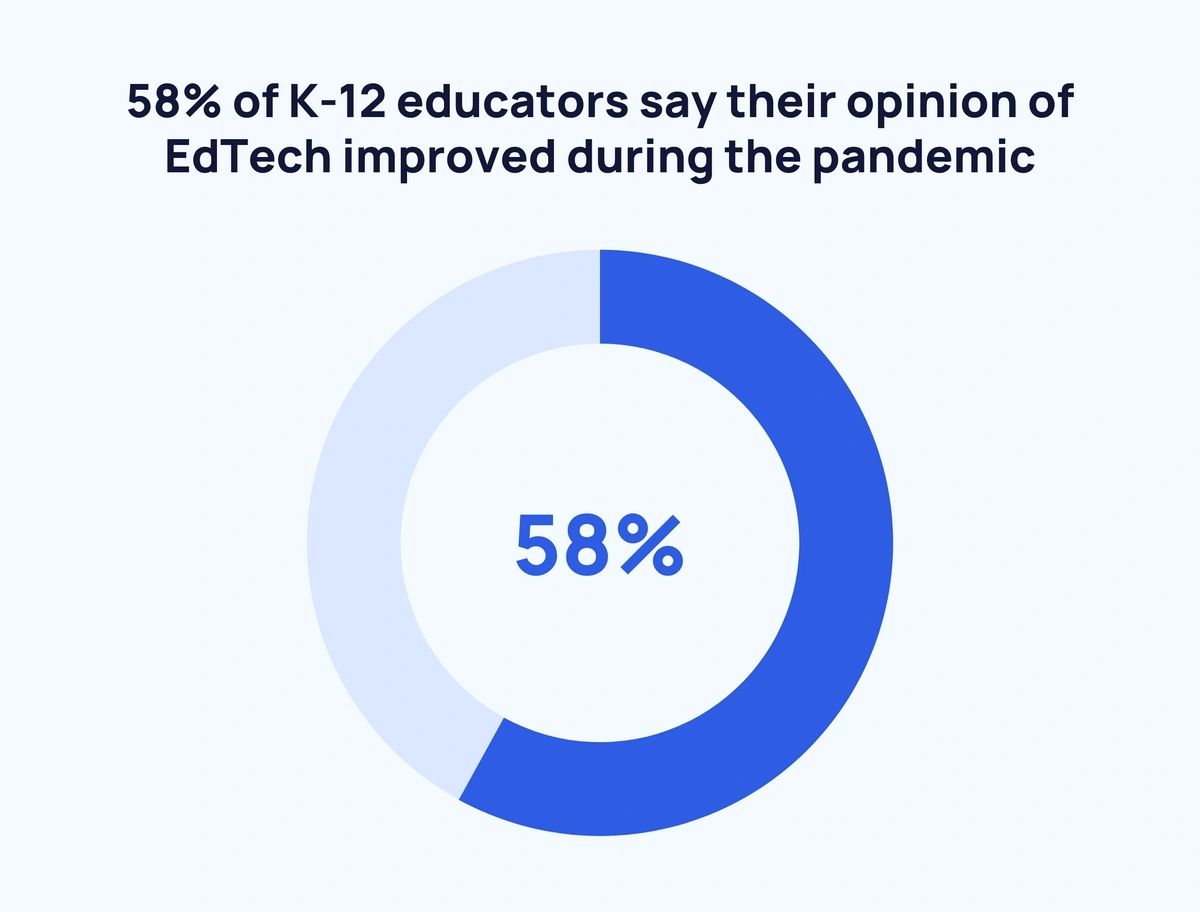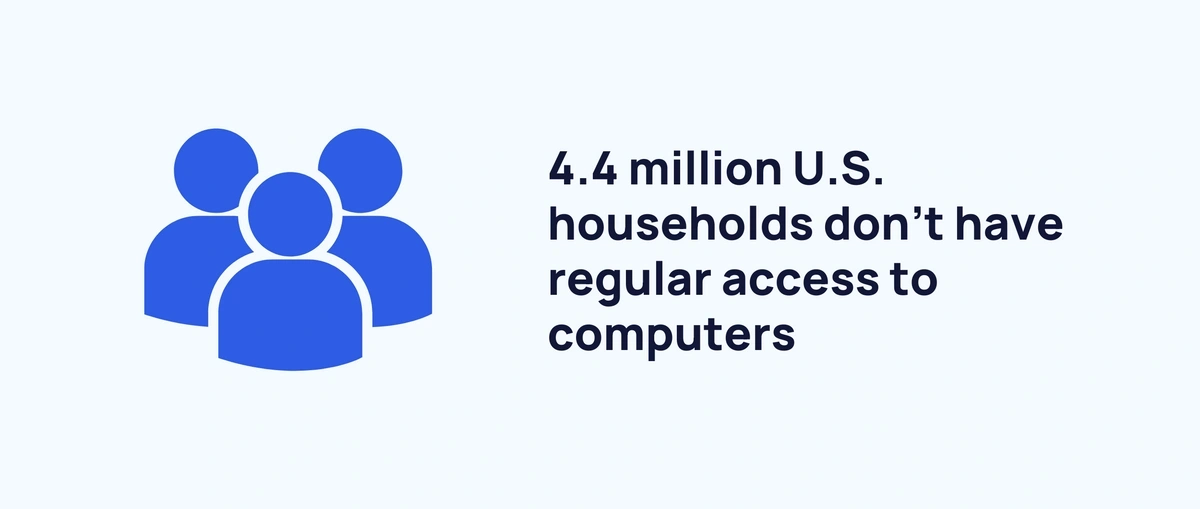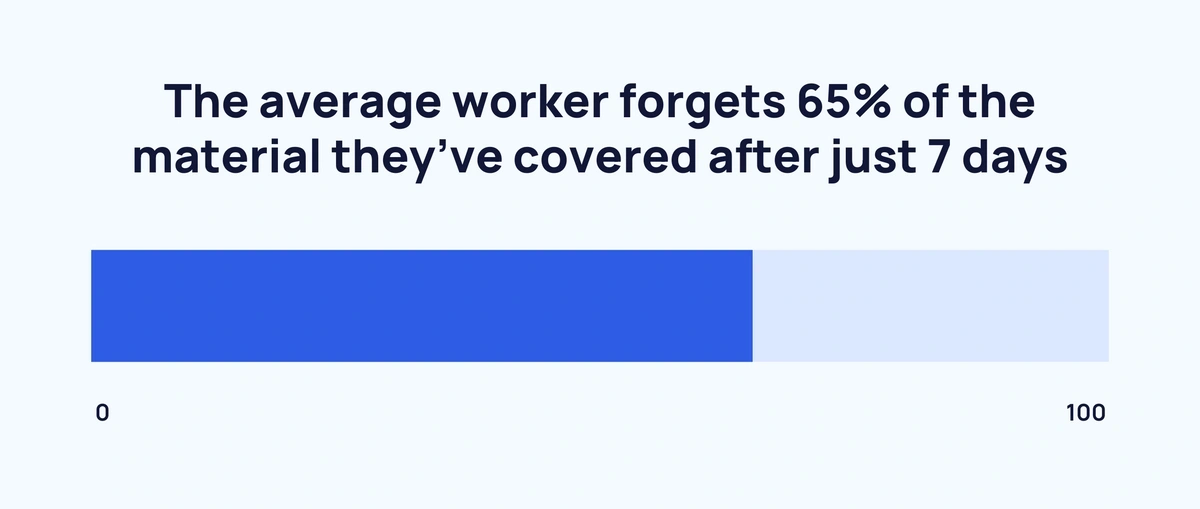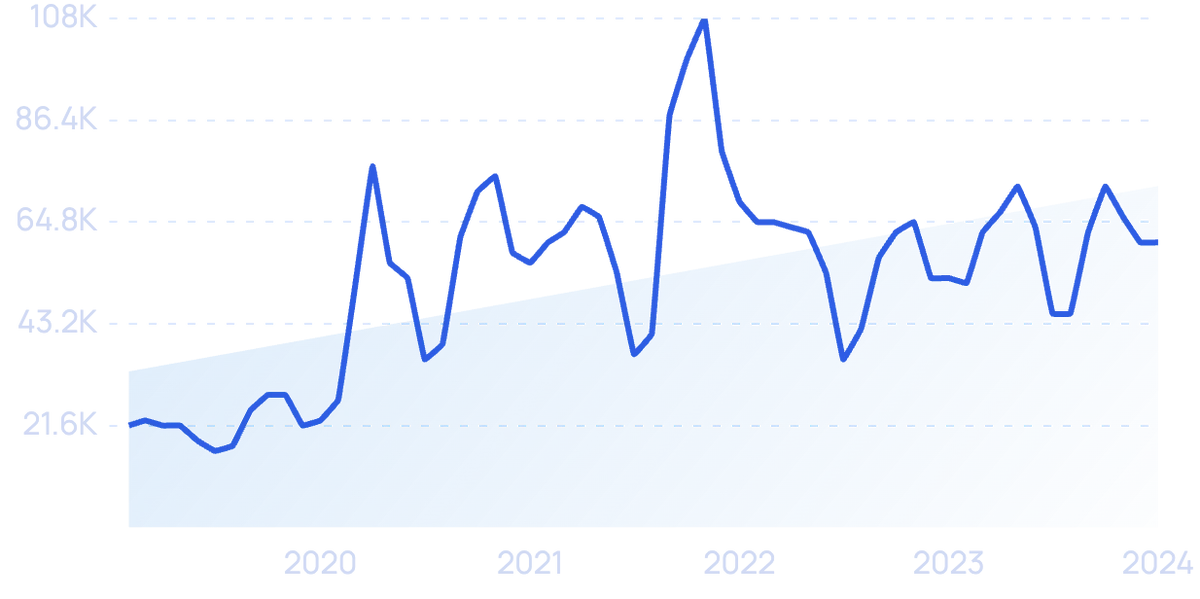
53+ EdTech Industry Statistics (2024)
This is an updated list of education technology (EdTech) stats for 2024.
Zoom lectures, virtual classrooms, and online courses may form EdTech’s foundation, but the industry goes much further than that.
Gamification, artificial intelligence, and virtual reality have all made their way into EdTech. Together, those technologies are changing the way people learn — from early childhood to professional life.
School and workplace closures introduced millions of people to EdTech over the past two years. As a result, the industry is looking to expand in exciting new ways.

What’s the state of EdTech today, and what will it look like in the future?
Read on to find out.
Content:
- Top EdTech Industry Stats
- EdTech Market Stats
- K-12 EdTech Statistics
- College EdTech Statistics
- Corporate EdTech Statistics
Top EdTech Industry Stats
Before reading the entire list of stats, here’s a quick peek at the EdTech industry:
- The EdTech market is worth $340 billion
- Corporate EdTech is a $27.5 billion industry
- EdTech usage in K-12 schools has increased 99% since 2020
- Over 70% of colleges expect to launch one or more online undergraduate programs in the next three years
- Digital learning is the most popular corporate skill-building strategy
EdTech Market Stats
Just how big is the EdTech industry? Which segments are poised for future growth? Here are the top EdTech market stats you need to know.
The EdTech market is worth $340 billion (Research and Markets)
The EdTech market includes all technology-based learning solutions for primary, secondary, and corporate education. Digital, remote learning is more widespread and accepted today than ever before.
The EdTech market could reach $605 billion in value by 2027 (Research and Markets)
EdTech should experience a 15% compounded annual growth rate over the next several years. A key driver behind that growth? New technology. Artificial intelligence, virtual reality, and the Internet of Things will all play a role in EdTech’s future.
The Corporate EdTech industry is valued at $27.5 billion (Valuates)
Corporate training and development is a draining expense for many organizations. EdTech gives companies a way to upskill their workforce in less time and for less money. Companies like Oracle, Skillsoft, and Blackboard are industry leaders.
The corporate EdTech industry could reach $44.6 billion by 2028 (Valuates)
Corporate EdTech’s market size could more than double over the next half-decade. While most of the EdTech market share belongs to North America, Europe, and the Asia-Pacific region should see faster growth this decade.
The adaptive learning market size is predicted to reach $9.11 billion by 2028 (Emergen Research)
Educators have learned that getting the best outcomes means adapting to each student’s unique personality and needs. Brain-training apps like Elevate help users learn more effectively with personalized content.
The K-12 game-based learning market is expected to grow 20% per year through 2025 (Technavio)
Game-based learning is on the rise. The industry is poised to add over $9 billion in market value in the first half of the 2020s. The US and Canada are forecasted to make up over one-third of that growth.
The augmented reality (AR) EdTech market is worth an estimated $5.3 billion (ABI Research)
Augmented reality offers new levels of immersion for students of all ages. Startups like Boulevard let students experience famous art and historical artifacts in augmented reality.
Sales from virtual reality headsets for education could reach $640 million in 2023 (ABI Research)
Along with augmented reality, virtual reality is expected to have a massive impact on EdTech in the near future. Beyond the Metaverse, startups like Labster make VR laboratories for students to safely run experiments.
Byju’s is the world’s leading EdTech unicorn with a $21 billion valuation (HolonIQ)
Byju’s, an Indian EdTech startup built around a freemium tutoring app, raised $800 million in its last funding round. The most valuable American EdTech unicorn is BetterUp, which offers professional learning and development solutions.
K-12 EdTech Statistics
As COVID circled the globe in 2020, primary schools had to scramble to adapt. Today, teachers and students know first-hand the rewards and challenges technology brings to the table.
87% of K-12 educators say their tech skills improved during the pandemic (EdWeek)
Widespread closures frustrated many teachers during the height of the COVID-19 pandemic. But many say that being forced to adapt actually made them more tech-savvy. Today, teachers are more comfortable merging technology with face-to-face learning.
Around 3 in 5 K-12 educators say their opinion on EdTech have improved since the pandemic began (EdWeek)
Opinions on EdTech are trending upward, but teachers and administrators have different views. 21% of teachers hold a more negative opinion about EdTech today than before COVID, as opposed to just 6% of administrators.
87% of K-12 teachers spent more time troubleshooting technology during COVID closures (EdWeek)
Dealing with EdTech’s learning curve means less time educating students. While time spent troubleshooting technology went up during the pandemic, 71% of teachers had to sacrifice time spent on student instruction.
Using internet-connected computers can raise students’ PISA scores by up to 30 points (McKinsey)
PISA – the Programme for International Student Assessment – measures reading, math, and science ability in 15-year-old students. Using internet-connected computers in the classroom correlates with 30 extra points in reading and science and 28 extra points in math.
Approximately 4.4 million US households don’t have regular access to computers (USA Facts)
Elearning is an important part of EdTech. But not all students have computers at home. 8% of US households sometimes, rarely, or never have computer access. Of the households that do have access, 60% received a computer from their child’s school.
EdTech usage in schools has increased 99% since 2020 (Learn Platform)
Prior to the pandemic, school districts averaged 703 EdTech solutions per month. Today, they use an average of 1403 EdTech solutions. Programs like SplashLearn help elementary students practice math and regularly send progress reports to parents.
US K-12 school districts access 1,403 EdTech solutions on average each month (Learn Platform)
Classroom engagement and instruction platforms like Kahoot! and Quizizz make up 23% of all edtech solutions used by K-12 schools. General solutions like Google’s suite of programs (Docs, Slides, Drives, etc.) make up another 18%.
3 out of 5 of K-12 teachers plan on continuing to give online assignments after the pandemic (Christensen Institute)
While most teachers plan to scale back technology in the classroom after the pandemic, they’re keen to maintain some practices. 61% say they’ll keep online assignments. Before the pandemic, only 47% of K-12 teachers would assign online coursework.
One-third of K-12 school systems will make fully remote learning an option after the pandemic (Christensen Institute)
Full-time virtual schools were a reaction to a public health crisis, but some systems are looking to keep the option in the future. Others plan to continue giving supplemental online courses or offer learning hubs for students.
College EdTech Statistics
Online degree programs have been around since the beginning of the internet. But EdTech can benefit all college students by giving them new ways to learn, study and communicate. Here’s how EdTech is changing the college experience.
4 out of 5 college students say EdTech solutions helped them improve their grades (McGraw-Hill)
College students are getting plenty of mileage out of EdTech. Over 80% say EdTech helps them improve grades, spend more time studying and learn more efficiently. They also feel there’s more progress to be made — 84% say they could use EdTech even more.
9 in 10 college students feel that EdTech solutions should adapt to their learning style (McGraw-Hill)
89% of students agree that adaptive learning technology is best, with 49% saying personalization is “extremely important.” 66% find adaptive technology like personalized quizzes helpful with learning and retention.
Challenge-based gamification can increase student outcomes by up to 35% (International Journal of Human-Computer Studies)
Gamification allows students to engage with topics in ways typical lectures can’t. As it turns out, gamification actually produces results. Gamification and reading combined can boost performance up to 60%.
Over 70% of colleges expect to launch one or more online undergraduate programs in the next three years (Wiley)
Demand for new online degree programs continues to climb as it becomes the preferred method of enrollment for many students. In fact, over half of online college students admit they’d abandon their school of choice if it didn’t offer an online program.
Around 3 in 4 college students want mobile access to course materials (Wiley)
Online college students tend to juggle work, family, and other obligations. Having mobile access to ebooks and lectures — not to mention open communication with professors and fellow students — lets students accomplish their goals no matter where they are.
Less than 1 in 8 online college students have enrolled in a massively open online course (MOOC) (Wiley)
MOOCs like Coursera and Udemy haven’t caught on with college students. Only 13% say they’ve ever enrolled in a free course. 4% say they haven’t yet but plan on enrolling within the next year.
Corporate EdTech Statistics
Learning doesn’t stop after college. Professionals must constantly improve to advance in their careers. EdTech solutions help organizations fine-tune their workforce’s hard and soft skills.
Employee training costs companies an average of $1,308 per year per employee (ATD)
Companies make significant investments in learning and development. EdTech presents an opportunity to bring those costs down by making learning more effective and efficient.
On average, workers forgets 65% of the material they’ve covered after just 1 week (Intuition)
After 6 months, workers forget up to 90% of the material covered through traditional workplace training. That means huge opportunities for EdTech companies that can boost those numbers.
Digital learning is the most popular corporate skill-building strategy (McKinsey)
Upskilling is a top focus in the corporate world. Post-pandemic, 58% of corporations say closing the skills gap is an even higher priority. 69% report bolstering their skill-building efforts. 75% find digital learning to be the most effective skill-building channel.
Time, budget, and content are the top three learning & development obstacles for HR managers (Talent LMS)
Educating and upskilling employees is a challenge for most organizations. When asked what their top learning and development challenges were, over 30% of human resources managers mentioned time, budget, and finding and updating content — all problems EdTech can solve.
41% of training professionals plan to invest in learning management systems (LMS) over the next year (Training)
Learning management systems help organizations streamline their learning and development strategies. By going mobile and digital, companies save money on expensive training materials while employees have the freedom to upskill on the go. Skillsoft’s mobile app Precipio is one of today’s top LMS platforms.
Searches for "learning management system" have increased by over 265% in the last 5 years.
Around 3 in 4 employees say they’re more likely to stay with employers who offer upskilling opportunities (Talent LMS)
Employees love learning new skills on the job. To make learning and development more effective, employees suggest making training content relevant, keeping it up-to-date, and adding a social element.
The Future of EdTech
As humans, we’re at our best when we’re learning new things and pushing our experiences to new boundaries. Technology gives us a path to learn more effectively and better retain our knowledge.
More and more people have access to high-speed internet and mobile devices every year. Advances in AI, AR, and VR will make learning more engaging and impactful. At the same time, we’ve grown more comfortable replacing in-person activities with their virtual counterparts.
All those factors paint an exciting picture for the future of EdTech.
For further insight into the EdTech market, take a look at Fast-Growing Edtech Companies & Startups and The Most Interesting EdTech Trends.
Stop Guessing, Start Growing 🚀
Use real-time topic data to create content that resonates and brings results.
Exploding Topics is owned by Semrush. Our mission is to provide accurate data and expert insights on emerging trends. Unless otherwise noted, this page’s content was written by either an employee or a paid contractor of Semrush Inc.
Share
Newsletter Signup
By clicking “Subscribe” you agree to Semrush Privacy Policy and consent to Semrush using your contact data for newsletter purposes
Written By


Josh is the Co-Founder and CTO of Exploding Topics. Josh has led Exploding Topics product development from the first line of co... Read more










